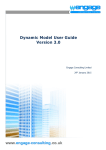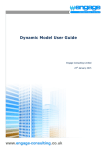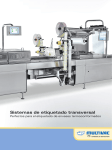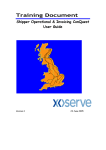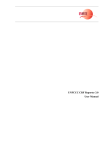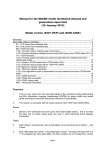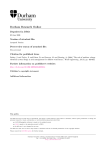Download Dynamic Model User Guide - Joint Office of Gas Transporters
Transcript
Engage Contact Details: +44 7827973224 [email protected] Dynam ic M odel User Guide Engage Consulting Limited 19th December 2014 Engage Consulting Limited www.engage-consulting.co.uk Registered in England, number: 3923081 Registered Office: 1st Floor Rear, 85 Hatton Garden, London EC1N 8JR VAT Registration: 754 7463 04 Page 1 of 23 Engage Contact Details: +44 7827973224 [email protected] Document Control Authorities Version Issue Date Author Comments 0.1 19th December 2014 Naomi Anderson First draft for review by the PAW and Ofgem Table of Contents Document Control ........................................................................................................................................ 2 Authorities ................................................................................................................................................... 2 Table of Contents ......................................................................................................................................... 2 1 Introduction ....................................................................................................................................... 3 1.1 2 Description of the Model .................................................................................................................... 4 2.1 2.2 2.3 2.4 3 Menu ....................................................................................................................................................... 6 Using the model ........................................................................................................................................ 6 Using the Model to Assess Performance Risks .................................................................................. 7 4.1 4.2 4.3 4.4 4.5 4.6 4.7 4.8 4.9 4.10 4.11 4.12 4.13 4.14 4.15 5 Model Construction ................................................................................................................................... 4 Value at Risk Report .................................................................................................................................. 4 Net Effect of Settlement Risks .................................................................................................................... 5 Compatibility............................................................................................................................................. 5 How to Navigate Through the Model ................................................................................................. 6 3.1 3.2 4 Background .............................................................................................................................................. 3 R1. Identified LDZ Offtake Measurement Errors ........................................................................................... 7 R2. LDZ Offtake Measurement Errors that remain undetected ...................................................................... 8 R3. Meter Reading Validation Failure .......................................................................................................... 9 R4. Failure to Obtain a Meter Reading ...................................................................................................... 10 R5. Estimated Reads used for daily read sites ........................................................................................... 10 R6. Meter Read Submission Frequency for Product 4 ................................................................................. 11 R7. Insufficient Maintenance of the Supply Point Register .......................................................................... 12 R8. Change of Shipper ............................................................................................................................. 12 R9. Late or Incomplete Check Reads ........................................................................................................ 13 R10. Shipperless Sites ............................................................................................................................. 14 R11. Theft of Gas .................................................................................................................................... 15 R12. Fair Use of the AQ Correction Process ............................................................................................... 15 R13. Lack of Winter Annual Ratio Band calculation for Sites in Product 4 ..................................................... 16 R14. Bias approach to retrospective updates ............................................................................................. 17 R15. Unregistered Sites ........................................................................................................................... 17 Updating Reference Data and Running Scenarios ........................................................................... 19 5.1 5.2 5.3 Shipper Matrix ........................................................................................................................................ 19 Common Data......................................................................................................................................... 19 Updating Risk Parameters ........................................................................................................................ 20 Engage Consulting Limited www.engage-consulting.co.uk Registered in England, number: 3923081 Registered Office: 1st Floor Rear, 85 Hatton Garden, London EC1N 8JR VAT Registration: 754 7463 04 Page 2 of 23 Engage Contact Details: +44 7827973224 1 1.1 [email protected] Introduction Background This user guide describes how to use the dynamic model, built in Excel, which simulates the Project Nexus settlements processes. The model will be used by the PAW to assess each performance risk identified within the Gas Market Settlement Risk Assessment report published on the Joint Office Website, 8th December. The model simulates the post Nexus settlement arrangements for an averaged sized LDZ with seven shippers operating in a competitive market. The core model is set up to replicate gas settlements without any risk to allocation or reconciliation volume for one day. To assess each risk the models uses an error distribution to identify the 1 in 20 worst-case event and quantify the inaccuracy that it would create if it materialised. Each risk can affect products 1-4 differently. The risk in kWh per day is run through the model to determine the value at risk and how it is distributed among shippers in the LDZ. The PAW will be able to update key reference data and run different scenarios to find the most appropriate value at risk. The model assesses the following risks: 1. Identified LDZ offtake measurement errors; 2. Undetected LDZ measurement errors; 3. Meter read validation failure; 4. Failure to obtain meter readings; 5. Estimated reads used on daily read sites; 6. Meter read submission frequency for product 4; 7. Insufficient maintenance of the supply point register; 8. Estimates used at change of shipper; 9. Late or incomplete check reads; 10. Shipperless Sites; 11. Theft of Gas; 12. Fair Use of the AQ correction process; 13. Lack of WAR Band calculation for qualifying sites in product 4; and 14. Fair use of retrospective updates. This document and the dynamic model assumes the reader has an understanding of the current and future gas settlement arrangements. Engage Consulting Limited www.engage-consulting.co.uk Registered in England, number: 3923081 Registered Office: 1st Floor Rear, 85 Hatton Garden, London EC1N 8JR VAT Registration: 754 7463 04 Page 3 of 23 Engage Contact Details: +44 7827973224 2 2.1 [email protected] Description of the Model Model Construction The model uses common data to convert the gas volume entering into an LDZ into identified and unidentified gas. These two categories are then split by product category to derive the initial allocation and reconciliation volume. The market shares are used to divide the energy allocation between the 7 shippers in the market. The reconciliation process simulates individual meter point reconciliation and the redistribution of energy through unidentified. The energy will be redistributed to Shippers’ based on an approximation of consumption over the last 12 months. Market share data is used as an approximate value. The model has market share data at the start and end of a model year and uses the average of the two values; this assumes a linear change from start to end. The basic model structure is shown below. Each of the risks vary the initial allocation or final reconciliation or both as they are fed through the model. The parameter control element of each risk determines which product category the risk impacts. 2.2 Value at Risk Report The Value at Risk (VAR) is determined as the difference between the cost incurred between the reference scenario where there are no risks and the scenario where the cumulative probability is 95%. The 95% worst-case scenario uses normal, binomial or poisson distributions shown in appendix A. The relevant distribution is determined dependant on whether the data is discrete or continuous. The graph below shows the probability distribution of a normal and binomial function. Engage Consulting Limited www.engage-consulting.co.uk Registered in England, number: 3923081 Registered Office: 1st Floor Rear, 85 Hatton Garden, London EC1N 8JR VAT Registration: 754 7463 04 Page 4 of 23 Engage Contact Details: +44 7827973224 Likelihood Black Scenario Pink Scenario Orange Scenario Most likely scenario Low 2.3 [email protected] Value at Risk Average metric for each risk 1 in 20 event 95th percentile scenario High Net Effect of Settlement Risks Where the risks has an equal and opposite impact only half of the risk is assessed. LDZ meter errors initially effect NTS shrinkage and this cost is then moved to energy allocation. The model does not assess the impact on NTS shrinkage. Similarly, where an estimated transfer read is used the impact to one shipper is evaluated. 2.4 Compatibility We have built the model in Excel 2013. It does not contain SQL or macros. This model requires a minimum of Excel 2007 as some formulas are not compatible with earlier versions and the information will not be displayed correctly. Engage Consulting Limited www.engage-consulting.co.uk Registered in England, number: 3923081 Registered Office: 1st Floor Rear, 85 Hatton Garden, London EC1N 8JR VAT Registration: 754 7463 04 Page 5 of 23 Engage Contact Details: +44 7827973224 3 3.1 [email protected] How to Navigate Through the Model Menu The menu tab is to navigate around the model. The user should update the selected risk with the number of the risk to be review from the list below. 3.2 Using the model The model simulates an average LDZ for an average settlement day. The model is currently configured to default specifications determined by Engage Consulting and can be run without any configuration by the PAW if desired. The default values are shown in Section 5. The model characteristics are sensitive to the size of shippers within the simulated LDZ and their product uptake. The common data also determines the volume of gas and number of customers. The current breakdown of the market has been determined to reflect reality with shippers having a mixed portfolio of customers. The common data has been determined to be an average LDZ. Some parameters used for probability distributions should be updated periodically following the publication of reports where others should be updated following request of ad hoc reports. How to update each risk is documented in section 4. Throughout the model the cells shown in light brown can be updated by the PAW. Engage Consulting Limited www.engage-consulting.co.uk Registered in England, number: 3923081 Registered Office: 1st Floor Rear, 85 Hatton Garden, London EC1N 8JR VAT Registration: 754 7463 04 Page 6 of 23 Engage Contact Details: +44 7827973224 4 [email protected] Using the Model to Assess Performance Risks The model documents which data has been used to obtain the 95% worst case scenario and where this data can be updated. In some instances where the risk is new or will differ significantly following Nexus go-live Engage have estimated the impact and probability. The risks have been grouped to minimise repetition. To use the model go to the Menu tab and select the risk that is to be evaluated firstly by typing in the relevant risk number. The table embedded within each risk shows the value at risk to shippers 1-7. This VAR is driven by product uptake and shipper market share. If this table is red the risk has not been correctly selected on the menu tab. 4.1 R1. Identified LDZ Offtake Measurement Errors The model assesses the risk offtake measurement errors create to accurate allocation. Any error is initially allocated to NTS shrinkage. When the LDZ throughput is corrected, volume adjustments will be picked up through unidentified gas reconciliation and shippers will be allocated energy correctly. 4.1.1 Data Used Data from the measurements errors registered which is kept on the Joint Office website is used to evaluate the probability and impact of an offtake error occurring on an LDZ. The register can be found here: http://www.gasgovernance.co.uk/MER. It is updated periodically when measurement errors are identified. We have used the following data: 4.1.2 • Number of meter errors: 127 errors; • Total number of offtake meters: 187 offtake meters; • Period: 8 years; • Average error which has been reported: 96,464 kWh per day; • Average length per error: 298 days; and • Total length period: 3650 days. Determining the 95% Worst-case Scenario In each case we are assessing the probability of the number of offtake meter errors occurring in our average LDZ on any given day. This can be approximated by a binomial probability distribution. The parameters are as follows; • n is the average number of offtake meters in an LDZ. This has been determined to be number of meters/number of LDZs; and Engage Consulting Limited www.engage-consulting.co.uk Registered in England, number: 3923081 Registered Office: 1st Floor Rear, 85 Hatton Garden, London EC1N 8JR VAT Registration: 754 7463 04 Page 7 of 23 Engage Contact Details: +44 7827973224 • [email protected] p is the probability of 1 meter having an error on any given day. This is determined as number of meter errors/ number of meters X average length per error/ total period measured. Using this distribution and the following parameters X-Binomial (14.38, 0.0641) the 95% worstcase scenario has been determined as 3 errors within the same LDZ on the same day. 4.1.3 Updating the Data The probability of an LDZ measurement error occurring on a given day should be updated when the measurement error register is updated. This should be updated by the average length of an LDZ meter error and length of time the sample covers. The total number of errors over the sample period should be updated. Risk 01 data should be updated with a refreshed version of the Measurement Errors Register following the identification and evaluation of an offtake meter error. Records with errors that do not have a start and end date must be removed. 4.2 R2. LDZ Offtake Measurement Errors that remain undetected Where an offtake measurement error is not detected then the error will never be corrected. Where an error occurs and remains undetected, the proportion of NTS Shrinkage will remain inaccurate. The model assess the risk to initial allocation and final reconciliation following the end of the settlement window. 4.2.1 Data Used Risk 2 should also be updated with information from the measurement errors register. The register can be found here: http://www.gasgovernance.co.uk/MER. We have used the same data as risk 1 and the probability of an error remaining undetected. 4.2.2 Determining the 95% Worst-case Scenario In each case we are assessing the probability of the number of offtake meter errors occurring on our average LDZ on any given day. This can be approximated by a Binomial probability distribution X – Binomial (n, p). Where n = 14.38 (number of meters on an average LDZ) and p = (number of meter errors/ number of meters) X (average length per error/ total period measured) X probability of remaining undetected. 4.2.3 Updating the Data The PAW should update the probability of a meter error occurring and the probability of it remaining undetected. Engage Consulting Limited www.engage-consulting.co.uk Registered in England, number: 3923081 Registered Office: 1st Floor Rear, 85 Hatton Garden, London EC1N 8JR VAT Registration: 754 7463 04 Page 8 of 23 Engage Contact Details: +44 7827973224 4.3 [email protected] R3. Meter Reading Validation Failure The model assesses the risk caused by meter read validation failure. Validation failure will occur when a comparison of the reading (and advance) against an expected value falls outside either of the two tolerance levels derived from the current AQ and/or SOQ. Alternatively, validation failure occurs when inaccurate reads falling inside the tolerance levels are accepted. When meter read validation failure occurs individual meter point reconciliation is suppressed, and the historic AQ remains live. It is likely that as consumption trends are falling this AQ will be on average, higher than actual consumption. The responsible shipper will pay for more gas than the supply point consumes and this will adjust unidentified gas accordingly. A risk to other shippers is created when the shipper pays for less gas than their customers consume. The principle risk because of meter read failure are inaccurate AQs and delayed reconciliations. There is a corresponding impact of late reconciliation on the unidentified gas reconciliation energy. 4.3.1 Data Used The Mod 81 report 10 has been used to determine the following data; • Average AQ; • Percentage change in AQ between 2013 and 2014;and • Standard deviation of the percentage change. Xoserve’s data of latest meter reading date, for all MPRNs in the East Midlands has been used to the number of MPRNs within the model that have not had a meter read accepted by Xoserve within the last 12 months. 4.3.2 Determining the 95% Worst-case Scenario The 95% worst case scenario has been calculated using a normal distribution with a mean average decrease based on the Mod 81 report calculated in kWh and a corresponding standard deviation. The 1 in 20 worst case would be determined by shippers increasing their consumption in a market where the average consumption was decreasing. 4.3.3 Updating the Data Data used to calculate the 1 in 20 worst case could be updated following the publication of the Mod 81 report in November by updating the percentage AQ change. Engage Consulting Limited www.engage-consulting.co.uk Registered in England, number: 3923081 Registered Office: 1st Floor Rear, 85 Hatton Garden, London EC1N 8JR VAT Registration: 754 7463 04 Page 9 of 23 Engage Contact Details: +44 7827973224 4.4 [email protected] R4. Failure to Obtain a Meter Reading The model assess the risk of shippers failing to obtain meter reads within the settlement window of 36-48 months. For ease of assessment, we have determined the settlement window to be 42 months. Where reads are not obtained the current AQ will be out of date and the MPRN will have incomplete reconciliation. 4.4.1 Data Used Where the current AQ is historic the true consumption is more likely to differ from the AQ. To assess the risk we have used data from Xoserve to determine the percentage of sites which do not have a read accepted on the UK Link system within the last 42 months. We have used the last 4 years Mod 81 reports to determine average yearly reduction in AQ. 4.4.2 Determining the 95% Worst-case Scenario We have applied a normal distribution to the last 4 years Mod 81 data to determine the compound 95% worst case difference between the AQ and the true consumption of the MPRNs which have not had a meter reads accepted by Xoserve. 4.4.3 Updating the Data The data can be updated when the Mod 81 reports are refreshed in November by updating the percentage AQ reduction. It may be possible to request from Xoserve an adhoc report showing the latest meter read acceptance date. 4.5 R5. Estimated Reads used for daily read sites The model assesses the risk of estimated reads being used to settle daily read sites. Daily read estimates for product 1 and 2 are generated to match the consumption 7 days previously and where there is no consumption history an estimate of AQ/365 will be used. The use of estimated reads will only materially affect settlement if there is no replacement read within gas flow day+5. MPRNs with significant usage can have volatile consumption. A consumption adjustment should be completed if the estimate does not reflect reality, however this is a manual process and there is no regulation to stipulate when this must be completed. The model assesses the impact of estimated reads being used for daily-metered sites. 4.5.1 Data Used The number of daily read estimates is derived using the total number of daily read sites and applying the percentage read failure falling outside both tolerance levels. This was published by Xoserve for the Project Nexus meeting on 24th November 2014. Data from the Mod 81 report can be used to determine the average AQ for EUC 07-09. Engage Consulting Limited Page 10 of 23 www.engage-consulting.co.uk Registered in England, number: 3923081 Registered Office: 1st Floor Rear, 85 Hatton Garden, London EC1N 8JR VAT Registration: 754 7463 04 Engage Contact Details: +44 7827973224 4.5.2 [email protected] Determining the 95% Worst-case Scenario A normal distribution has been used to determine the 95% worst-case scenario with µ=840,154 kWh the average AQ for EUC 07-09 and standard deviation of 8,227,834 kWh. The 95% worst-case scenario has been determined as a daily difference between estimate and actual as 39,452kWh. 4.5.3 Updating the Data In November the Mod 81 Report 10 can be used to update the mean AQ of MPRNs within EUC product 07-09. This data should be updated on the Risk 05 data tab. The percentage of meter read failures should be updated in the cell shown in light brown on the spreadsheet. 4.6 R6. Meter Read Submission Frequency for Product 4 This assesses the risk created by infrequent meter read submissions for sites in product 4. Where read frequency is lower there is a higher chance that the AQ will not reflect true consumption. The risk has been set up to consider all MPRNs in product 4. 4.6.1 Data Used This risk uses similar data to risk three as shown below; 4.6.2 Determining the 95% Worst-case Scenario The 95% worst case scenario is determined by all MPRNs from polluting shippers in product 4 have an understated AQ. Engage Consulting Limited Page 11 of 23 www.engage-consulting.co.uk Registered in England, number: 3923081 Registered Office: 1st Floor Rear, 85 Hatton Garden, London EC1N 8JR VAT Registration: 754 7463 04 Engage Contact Details: +44 7827973224 4.6.3 [email protected] Updating the Data The Mod 81 report should be used to update the AQ data. Xoserve may be able to provide an updated adhoc report containing latest meter read date for MPRNs in Product 4. 4.7 R7. Insufficient Maintenance of the Supply Point Register The model assess the risk created due to the supply point register not being accurately maintained. When meter readings are obtained the meter point detail submitted by the shipper must match the supply point register. Where logic checks fail and the read submitted does not match the supply point register the read will not flow through into settlement. This risk assesses the impact of inconsistent asset data. 4.7.1 Data Used We have used the average AQ from the Mod 81 report. An estimate of the percentage of MPRNs which fail fuzzy matching checks. 4.7.2 Determining the 95% Worst-case Scenario To demonstrate the 95% worst case scenario we have used the resultant impact of the imperial and metric indicators being swapped. 4.7.3 Updating the Data On request Xoserve may be able to provide information around the percentage of MPRNs which fail fuzzy matching. 4.8 R8. Change of Shipper The model assess the risk created by estimated reads at change of supply. Where the shipper fails to provide any reading during a change of shipper, the transporter will provide an estimate 16 days following the transfer date. Change of shipper reads can be replaced with a shipper agreed read up to 12 months after the change of supply date. Where a change of shipper is completed using an estimate transfer read and not replaced with an actual read, the closed reconciliation period of the previous shipper will end on an estimate and the new reconciliation period will begin on the same estimate. An estimated meter reading could be used because no actual reading was obtained, because the actual transfer read was rejected due to data discrepancies or because it failed validation tolerances due to an incorrect AQ. We have assessed the risk of estimated transfer reads on accurate reconciliation. This risk principally affects product 4 sites and the length of time between reads provides a higher probability that the estimate will be inaccurate. Where the transfer read does not reflect reality the final allocation of energy to each shipper may be incorrect. Any misallocation in energy impacts the two shippers who have been responsible for the meter point. 4.8.1 Data Used Data has been provided by Xoserve for the number of supply point confirmations by month and the percentage of estimated transfer reads used. The percentage of MPRNs that change shipper is deduced using the data provided by Xoserve and the total number of MPRNs on the Mod 81 Engage Consulting Limited Page 12 of 23 www.engage-consulting.co.uk Registered in England, number: 3923081 Registered Office: 1st Floor Rear, 85 Hatton Garden, London EC1N 8JR VAT Registration: 754 7463 04 Engage Contact Details: +44 7827973224 [email protected] report which are live on the supply point register on 1st October. Xoserve can provide an updated adhoc report detailing the change of supply percentage and percentage of estimated reads used. To determine the average difference in AQ we have used the average reduction from the latest Mod 81 report 10. The average number of days between meter reads for product 4 have been taken from an extract of showing all of the meter readings in the East Midlands. 4.8.2 Determining the 95% Worst-case Scenario A binomial distribution has been used with parameters n = number of change of shipper events and p = probability the transfer read remains as an estimate. 4.8.3 Updating the Data Xoserve can provide adhoc reports on the following; • Number of supply point confirmations per month; • Percentage of estimated transfer reads; • Number of SARs that have been accepted; and • Latest meter read date which can be used to determine meter read frequency. AQ change can be determined from the latest Mod 81 report. 4.9 R9. Late or Incomplete Check Reads Nexus rules transfer the check read obligation from transporters to shippers where equipment is in place which derives meter readings. If shippers do not fulfil their obligation there is a risk that metering drift will not be correctly assigned to the right shippers. Shippers are required to complete check reads for all metering equipment that derives a read within the 12 months for MPRNs in products 1-3 and monthly read sites in product 4 and every 24 months for annually read sites within product 4. This risk is principally applied to product 2 and product 3. The risk of not completing these check reads is that drift is not identified. 4.9.1 Data Used We have used data from Mod 81 report 10 to determine the average AQ for EUC 03-09 as an approximation for the AQ of sites which would require a check read. We have estimated the number of sites requiring a check reads and the impact of not completing these check reads. Engage Consulting Limited Page 13 of 23 www.engage-consulting.co.uk Registered in England, number: 3923081 Registered Office: 1st Floor Rear, 85 Hatton Garden, London EC1N 8JR VAT Registration: 754 7463 04 Engage Contact Details: +44 7827973224 4.9.2 [email protected] Determining the 95% Worst-case Scenario The 95% worst case has been determined as 5% of qualifying sites have not had a check read completed. 4.9.3 Updating the Data The average AQ for MPRNs in EUC 03-09 can be updated yearly from the Mod 81 report. It may be possible for Xoserve to provide a report of all MPRNs where meter require a check read following project Nexus go-live. A report from Xoserve could be used to determine a more accurate AQ for meters that derive reads. 4.10 R10. Shipperless Sites The model evaluates the performance risk created because of shippers erroneously withdrawing from sites that continue to consume gas. All energy consumed by shipperless sites is allocated to unidentified energy. 4.10.1 Data Used Xoserve have provided a report on the number of isolations per year. The probability of a site which has been withdrawn from still consuming gas has been determined as 0.05 (5%). The average AQ has been determined using the Mod 81 report. Engage has determined the detection rate to be 50% per annum. 4.10.2 Determining the 95% Worst-case Scenario A binomial distribution has been used with parameters n = number of isolations per day and p=probability an isolation has been completed but the site continues to consume gas. 4.10.3 Updating the Data The PAW can update the parameters shown in light brown. This includes; • The number of isolations per year; • The probability of a site continuing to consume gas; and • The detection rate of the shipperless sites, which have been created. Engage Consulting Limited Page 14 of 23 www.engage-consulting.co.uk Registered in England, number: 3923081 Registered Office: 1st Floor Rear, 85 Hatton Garden, London EC1N 8JR VAT Registration: 754 7463 04 Engage Contact Details: +44 7827973224 [email protected] The model can be run using different parameters as the effects of UNC Modification 410, 424 and 425 are more widely understood and further data becomes available. 4.11 R11. Theft of Gas Theft of gas creates a risk to shipper allocation as unidentified gas is artificially inflated. Any theft of gas that occurs and is not allocated to any shipper. The model evaluates the value at risk created mis-allocation of gas volume to the market. The AUGE report evaluate the suspected amount of theft. We have used a range from the latest AUGE statement to evaluate the worst-case scenario. 4.11.1 Data Used The latest AUGE statement provides a range of percentages, which we have used to evaluate risk. 4.11.2 Determining the 95% Worst-case Scenario The 1 in 20 worst case scenario has been determined using information from page 13 of the AUGE statement which identifies that theft may be as much as 10% of throughput. 4.11.3 Updating the Data The PAW should update the percentage theft from the AUGE statement, if the AUGE process becomes redundant, it may be possible to update the 1 in 20 worst-case scenario using information provided through the TRAS service. 4.12 R12. Fair Use of the AQ Correction Process When an AQ or SOQ prevents correct meter readings being accepted by Xoserve an AQ correction can be submitted by the shipper. Following the correction an updated AQ or SOQ would allow future meter reads to be accepted by Xoserve and used for individual meter point reconciliation. We have assessed the risk of shippers using the AQ correction process in a biased way i.e. only correcting AQ reductions. Where only AQ reductions are completed any corresponding increases to consumption will be picked up through unidentified gas. The impact of AQ corrections will be created by MPRNs in product 4. 4.12.1 Data Used We have used data provided on the Mod 81 report 2 to determine the average number of decreasing AQs and the standard deviation amongst shippers. Xoserve has provided a report of the latest meter readings for all MPRNs in the East Midlands and we have used this to determine that the average time between meter readings is 136 days. The number of meter reads which will fail tolerances as a result of AQ/SOQ being incorrect was provided by Xoserve to the Project Nexus workgroup on 24th November 2014. Engage Consulting Limited Page 15 of 23 www.engage-consulting.co.uk Registered in England, number: 3923081 Registered Office: 1st Floor Rear, 85 Hatton Garden, London EC1N 8JR VAT Registration: 754 7463 04 Engage Contact Details: +44 7827973224 4.12.2 [email protected] Determining the 95% Worst-case Scenario A normal distribution has been used to determine the 1 in 20 worst-case percentage change in AQs. The maximum number of AQ corrections has been determined as the number of meter read failures that cannot be corrected and resubmitted. The maximum change in consumption has been determined as the same volume in kWh as within risk 3. 4.12.3 Updating the Data Initially AQ values can be updated following the publication of the Mod 81 report 2 in November. Xoserve may be able to provide updated information on actual meter read rejection percentages following project Nexus go-live. Xoserve may also be able to provide updated information on meter read frequency on an adhoc basis, but this should be discussed between Xoserve and the PAW. 4.13 R13. Lack of Winter Annual Ratio Band calculation for Sites in Product 4 The model assesses the risk of not completing a site-specific winter consumption profile on sites in product 4. Currently a Winter Annual Ratio (WAR) is used to determine a site-specific winter consumption for a monthly read site with an AQ > 293,000kWh. It is calculated as the December to March consumption divided by the AQ. If the meter readings are not available to complete a site specific WAR the default EUC profile is used. Following Nexus go-live product 3 sites will be reconciled monthly so the effect will be minimal. The main effect will be a profiling effect to initial allocation of all sites within product 4. 4.13.1 Data Used The Mod 81 report 10 has been used to determine the percentage of sites that should have a site specific WAR band. The average AQ of these MPRNs is also determined from the Mod 81 report. Engage Consulting Limited Page 16 of 23 www.engage-consulting.co.uk Registered in England, number: 3923081 Registered Office: 1st Floor Rear, 85 Hatton Garden, London EC1N 8JR VAT Registration: 754 7463 04 Engage Contact Details: +44 7827973224 4.13.2 [email protected] Determining the 95% Worst-case Scenario It is anticipated that Xoserve will provide data on the percentage of WARs completed currently and the average difference in winter consumption between MPRNs with a site specific WAR and the standard WAR. 4.13.3 Updating the Data In November the Mod 81 report can be used to update the percentage of MPRNs which should have a site specific WAR. Xoserve maybe able to provide an adhoc report showing the number of product 4 MPRNs which should have a site specific WAR going forward. 4.14 R14. Bias approach to retrospective updates Following Nexus go-live shippers will be able to update historic data items more readily. The model assesses the risk of shippers not completing retrospective updates in a fair and even way. We anticipate that shippers will take an unbiased approach to updating this information to ensure the supply point register is accurate. Where retrospective updates have an impact on consumption a reconciliation or a re-reconciliation will be completed. It would be possible for a shipper to use the retrospective updates process only where they are advantaged financially. 4.14.1 Data Used As this is a new process there is little data currently available to use to derive the most appropriate distribution which models the risk and its corresponding probability. The average AQ has been taken from the Mod 81 report. Engage have estimated the percentage of MPRNs that require a retrospective update and impact energy consumption. Engage have also estimated the average impact on reconciliation as a percentage. 4.14.2 Determining the 95% Worst-case Scenario A Poisson Distribution has been applied to this data set using the average impact to reconciliation volume per MPRN. 4.14.3 Updating the Data Xoserve may be able to provide the number of consumption adjustments that are currently processed using RFA and CDQ queries in the query management system. 4.15 R15. Unregistered Sites The model evaluates the performance risk created as a result of unregistered sites which have never been on the supply point register. All energy consumed these sites are allocated to unidentified energy. Engage Consulting Limited Page 17 of 23 www.engage-consulting.co.uk Registered in England, number: 3923081 Registered Office: 1st Floor Rear, 85 Hatton Garden, London EC1N 8JR VAT Registration: 754 7463 04 Engage Contact Details: +44 7827973224 4.15.1 [email protected] Data Used Xoserve have provided a report on the number of MPRN creations per year. The probability of a site which has been withdrawn from still consuming gas has been determined as 0.05 (5%). The average AQ has been determined using the Mod 81 report. 4.15.2 Determining the 95% Worst-case Scenario A binomial distribution has been used with parameters n = number of MPRNs created per day and p=probability is the probability of these MPRNs being created and not consuming gas. 4.15.3 Updating the Data The PAW can update the following parameters; • The number of MPRN creations per year; • The probability of a site not being registered and consuming gas; and • The detection rate of the unregistered sites. Engage Consulting Limited Page 18 of 23 www.engage-consulting.co.uk Registered in England, number: 3923081 Registered Office: 1st Floor Rear, 85 Hatton Garden, London EC1N 8JR VAT Registration: 754 7463 04 Engage Contact Details: +44 7827973224 5 [email protected] Updating Reference Data and Running Scenarios This data should be updated by the PAW to assess the value at risk in different market conditions. The uptake of different settlement product categories is likely to change as shippers develop their own strategies to optimise the new functionality created through Project Nexus. 5.1 Shipper Matrix This contains static data that defines the characteristics of the market that is modelled. Unidentified Gas is allocated on consumption for the last 12 months so the current day’s market shares and previous years market share of energy consumption are required. These shares must be broken down by product category for each shipper. The PAW can update the overall product split of the settlement market. The PAW can also update the product split by overall meters, as some risks such as change of supply is dependent on both energy consumption and number of meters. The cells that are light brown in the shipper matrix tab should be agreed and updated manually by the PAW. Shipper 1-3 are coloured red to represent polluting shippers. These shippers realise the risks and their allocation and reconciliation will have corresponding errors simulated. The risks pollute the other shippers and their allocation and reconciliation where appropriate. 4-6 are polluted shippers and will not negatively affect settlement allocation. Shipper 7 is the residual market. 5.2 Common Data This common data determines the key characteristic of the LDZ. The model looks at one settlement day and extrapolates this risk to a year. The PAW can update the data items shown in pink. Calorific value is the average forecast obtained from Distribution Network Operators shrinkage statements. MPRNs is an approximate size of an average LDZ. The LDZ size is the total gas usage in m3 for 23rd November divided by 13. The Unidentified Gas is 1% of throughput as approximated by the AUGE. The system average price is the average price for gas year 2013/2014. Data can be used to refresh the AUGE percentage following publication of their yearly statement. Average CVs are published in the DN shrinkage statements. National Grid’s data Item Explorer Website can be used to determine the most appropriate system price to be used in the settlement calculations. Engage Consulting Limited Page 19 of 23 www.engage-consulting.co.uk Registered in England, number: 3923081 Registered Office: 1st Floor Rear, 85 Hatton Garden, London EC1N 8JR VAT Registration: 754 7463 04 Engage Contact Details: +44 7827973224 5.3 [email protected] Updating Risk Parameters The PAW should adjust the parameter control tab if it is felt that a risk has moved from one product category to another or from allocation to reconciliation. This can be done by unhiding the parameter control section between column A and E within each risk tab. The parameter can then be changed from false to true or vice versa for each product and whether it impacts allocation or reconciliation. This is have we have determined how the risk affects initial allocation and reconciliation this tab should only need to be updated following changes to market rules. Engage Consulting Limited Page 20 of 23 www.engage-consulting.co.uk Registered in England, number: 3923081 Registered Office: 1st Floor Rear, 85 Hatton Garden, London EC1N 8JR VAT Registration: 754 7463 04 Engage Contact Details: +44 7827973224 Appendix A [email protected] Probability Distributions We have used three cumulative probability distributions to determine the 95% worst-case scenario. Binomial and Poisson distributions are for discrete events, i.e. these distributions have been used for customers changing shipper, where only a whole number of change of shipper events can occur. Normal distributions are used for continuous probability such as energy consumption. A1 Binomial Distribution The binomial distribution is for x discrete events it has parameters n and p and is characterised as follows; • n is the number of independent events, n must be a whole number. • p is the probability of a success occurring where p must be between 0-1 • q is 1-p • X is number of success that occurring from a total of n trials. Probability = 0.95 A2 Poisson Distribution Poisson distribution is a discrete probability distribution with parameter λ. There must be a whole number of events and they must be independent of each other. The Poisson Distribution is characterised as follows; • λ = mean number of successes, λ > 0. • Poisson can be used as an approximation for a binomial distribution when n is large and p is small. • Poisson distribution is not symmetrical. Engage Consulting Limited Page 21 of 23 www.engage-consulting.co.uk Registered in England, number: 3923081 Registered Office: 1st Floor Rear, 85 Hatton Garden, London EC1N 8JR VAT Registration: 754 7463 04 Engage Contact Details: +44 7827973224 [email protected] Probability = 0.95 A3 Normal Distribution To be used for continuous probability distributions taking a symmetrical distribution. Normal distribution take parameters µ and σ2 with the following characteristics; • µ = mean and σ2 = standard deviation of a set of data. • In diagram A below z is the number of successes, this shows a 95% score of less than z. • Diagram B shows how to find the 5% probability where there is a negative mean (where AQs are decreasing). A B Engage Consulting Limited Page 22 of 23 www.engage-consulting.co.uk Registered in England, number: 3923081 Registered Office: 1st Floor Rear, 85 Hatton Garden, London EC1N 8JR VAT Registration: 754 7463 04 Engage Contact Details: +44 7827973224 Engage Consulting Limited [email protected] Page 23 of 23 www.engage-consulting.co.uk Registered in England, number: 3923081 Registered Office: 1st Floor Rear, 85 Hatton Garden, London EC1N 8JR VAT Registration: 754 7463 04























